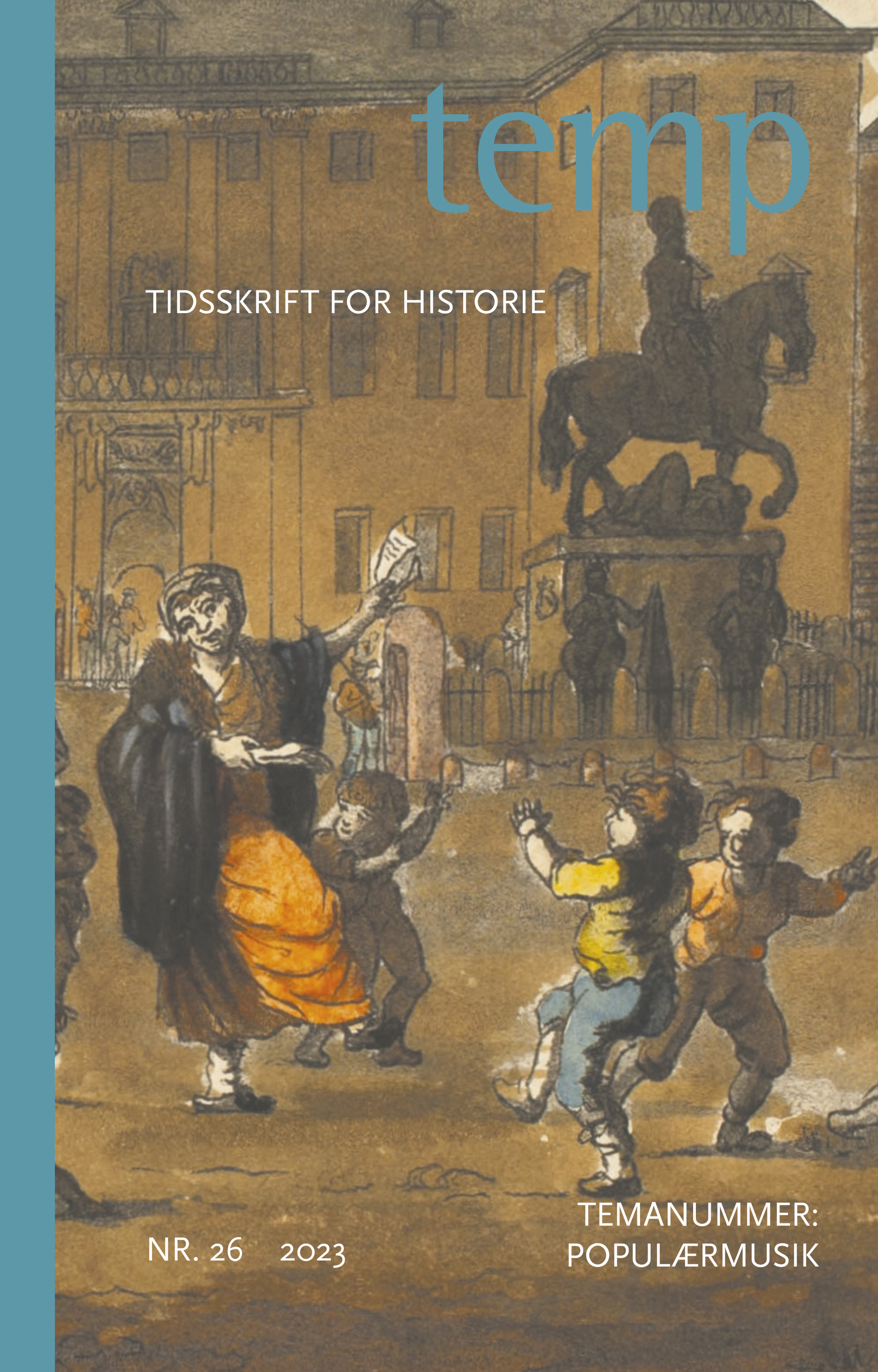Digital kulde og klanglig realisme
Populærmusik, lydteknologi og skiftende lydidealer
Nøgleord:
Lydidealer, klang, lydteknologiResumé
Artiklen undersøger hvordan den optagede populærmusik og nye lydteknologier er blevet beskrevet i amerikanske musikmedier, og hvordan disse beskrivelser kan ses som et udtryk for lytternes sensoriske virkelighed i bredere forstand. Nye lydindspilnings- og afspilningsteknologier har løbende ændret betingelserne for den lyd musiklytterne er blevet mødt med, og idealet for ’den gode lyd’ har en ændret sig på afgørende punkter fra de tidlige mekaniske optagelser over introduktionen af flersporoptagelsen til udbredelsen af den digitale lyd.
Musikproducenternes fokus på at skabe realistiske indspilninger i begyndelsen af 1900-tallet, blev i midten af 1900-tallet suppleret af nye forståelseskategorier, hvor idealet for den optagede musik i højere grad pegede med en særegen æstetik, der ikke havde den virkelige verden som reference. Den optagede musik blev nu beskrevet gennem multimodale metaforer – som når lydens kvalitet blev beskrevet som ’varm’ eller ’blød’. Artiklen argumenterer for, at den måde at forstå og kategorisere auditive sanseoplevelser, som de sproglige metaforer er et udtryk for, kan studeres som fragmenter af hverdagens betydningsproduktion. Metaforerne illustrerer menneskers forestillingsevne, og de åbner for en dybere forståelse af rammerne for sanselig erkendelse på et givent tidspunkt i historien.
Referencer
Billboard: “Johnny Nash – “As Time Goes By”; “The Voice of Love””, 23.2.1959.
Billboard: ”Petula Clark – Now”, 13.1.1973.
Billboard: “Victor to Spend 250G Promoting HiFi Disks”, 21.8.1954.
Block, Debbie, Billboard: ”Positive Feedback Heard On Direct-Stream Digital”, 29.6.1996.
Brock-Nannestad, George og Jean-Marc Fontaine: “Early Use of the Scott-Koenig Phonoautograph for Documenting Performance”, Paper præsenteret på Acoustics ’08, Paris, 2008.
Cunningham, Mark: Good Vibrations. A History of Recording Production, Chessington, Surrey: Castle Communications, 1996.
Dewey, John: “The Role of Philosophy in the History of Civilization”, The Philosophical Review, 36 (1), 1927, 1-9.
Doyle, Peter. “From ‘My Blue Heaven’ to ‘Race with the Devil’: Echo, Reverb and (Dis)ordered Space in Early Popular Music Recording”, Popular Music, 23 (1), 2004, 31-49.
First Sounds: https://www.ϐirstsounds.org/research/ (15.9.2022).
First Sounds: ”Humanity’s First Recording of its Own Voice”. https://www.youtube.com/watch?v=75UrxueiP-4 (4.4.2023).
Furchgott, Roy, New York Times: “Warm Sound of Old in a Cold Compressed World”, 15.9.2022.
Gelatt, Roland: The Fabulous Phonograph, 1877-1977, London: Cassell, 1977.
Goodwin, Andrew: “Sample and Hold: Pop Music in the Digital Age of Reproduction”, Critical Quarterly, 30 (3), 1988, 34-49.
Guralnick, Peter: Sam Philips – The Man Who Invented Rock’n’Roll, New York: Little, Brown and Company, 2014.
Halmrast, Tor: “Sam Phillips Slap Back Echo; Luckily in Mono”, ́ Proceedings of the 12th Art of Record Production Conference, 2019, 137-154.
“Invention of the Phonograph”. https:/ https://www.youtube.com/watch?v=qGJR2DZBfF0 (4.4.2023).
Johnson, Mark: The Aesthetics of Meaning and Thought: The Bodily Roots of Philosophy, Science, Morality, and Art, Chicago: The University of Chicago Press, 2018.
Les Paul Official: “Les Paul and Mary Ford on “Omnibus” (1953)”. https://www.youtube.com/ watch?v=VCEmAgak9V8. (4.4.2023).
Milner, Greg: Perfecting Sound Forever: The Story of Recorded Music, Bodmin, Cornwall, Granta, 2011.
Morton, David L.: Sound Recording: The Life Story of a Technology, Baltimore: The John Hopkins University Press, 2006.
Reynolds, Simon: Retromania: Pop Culture’s Addiction to Its Own Past, New York: Farrar, Straus and Giroux, 2011.
Rosa, Hartmut: Fremmedgørelse og acceleration, København: Hans Reitzels Forlag. 2014.
Ryan, Camille: Computer and Internet Use in the United States: 2016. US Census Bureau, August 2018. https://www.census.gov/content/dam/Census/library/publications/2018/acs/ACS39.pdf (15.9.2022).
Schaeffer, Pierre: Traité des objets musicaux: Essai interdisciplines, Paris, 1966.
Peterson, Richard A: “Why 1955? Explaining the Advent of Rock Music”, Popular Music, 9 (1), 1990, 97-116.
Théberge, Paul: Any Sound You Can Imagine: Making Music, Consuming Technology, Hanover: Wesleyan University Press, 1997.
Thompson, Emily: “Machines, Music and the Quest for Fidelity: Marketing the Edison Phonograph in America 1877–1925”, Musical Quarterly, 79 (1), 1995, 131-171.
Zhong, Chen-Bo og Geoffrey J. Leonardelli: “Cold and Lonely: Does Social Exclusion Literally Feel Cold?”, Psychological Science, 19 (9), 2008.
Various Artists: Pure, Perfect Sound – Forever: Philips Compact Disc, Philips, 1982, CD. https://www.allmusic.com/album/pure-perfect-sound-forever-philips-compact-discmw0002143685/releases (5.4.2023).
Verna, Paul, Billboard: “The Knit Expands Studio Role”, 10.1.1998.
Walther-Hansen, Mads: Making Senses of Recordings: How Cognitive Processing of Recorded Sound Works. New York: Oxford University Press.
Wimble, Bert, Billboard: ”What Shall We Do Tomorrow? An Inspirational Article for Phonograph Operators”, 28.1.1939.
World Radio History: https://worldradiohistory.com/Archive-All-Music/Billboard-Magazine. htm (15.9.2022).
Downloads
Publiceret
Citation/Eksport
Nummer
Sektion
Licens
Copyright temp - tidsskrift for historie og forfatterne.
Artikler publiceret i Temp må citeres, downloades og videresendes for ikke-kommerciel brug, under forudsætning af normal akademisk reference til forfatter(e) samt tidsskrift, årgang, nummer og sider. Artiklerne må kun genudgives med eksplicit tilladelse fra forfatter(e) og tidsskriftet.





